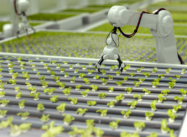SAP Smart Sensing
Filter By
Browse By
- SAP Analytics and AI
- SAP Application Development and Integration
- All SAP Application Development and Integration
- SAP ABAP
- SAP ABAP Development Tools
- SAP ABAP Test Cockpit
- SAP API Management
- SAP BAPI
- SAP Basis
- SAP BRF
- SAP Business Application Studio
- SAP CMS
- SAP Design Studio
- SAP Development Tools
- SAP DevOps
- SAP EAI
- SAP EDI
- SAP Extension Suite
- SAP Fiori
- SAP Fiori Elements
- SAP Integration Suite
- SAP Low Code Application Development
- SAP Low Code Automation
- SAP Netweaver
- SAP Release Management
- SAP UI5
- SAP Web Application Server
- SAP Web IDE
- SAP Business Process Management
- SAP Center of Excellence
- SAP CIO
- SAP Customer Experience
- SAP Data and Data Management
- All SAP Data and Data Management
- SAP BW
- SAP BW/4HANA
- SAP Crystal Reports
- SAP Data Archiving
- SAP Data Center
- SAP Data Governance
- SAP Data Integration
- SAP Data Migration
- SAP Data Quality
- SAP Data Services
- SAP Data Strategy
- SAP Data Visualization
- SAP Data Warehouse Cloud
- SAP DMS
- SAP Document Control
- SAP EIM
- SAP ETL
- SAP ETL Tools
- SAP HANA
- SAP HANA Administration
- SAP HANA Deployment Infrastructure
- SAP HANA Studio
- SAP Master Data
- SAP Master Data Governance
- SAP MDM
- SAP Enterprise Architect
- SAP Enterprise Asset Management
- SAP ERP
- SAP Finance
- All SAP Finance
- SAP Accounting
- SAP AR AP
- SAP Asset Accounting
- SAP Billing Systems
- SAP BPC
- SAP BRIM
- SAP Cash Management
- SAP Central Finance
- SAP Controlling
- SAP COPA
- SAP Cost Center Accounting
- SAP Currency Risk
- SAP e-invoicing
- SAP FICO
- SAP Finance Automation
- SAP Advanced Financial Closing
- SAP Financial Consolidation
- SAP Financial Planning
- SAP FX Risk
- SAP General Ledger
- SAP Global Tax Management
- SAP Hyperion
- SAP Order to Cash
- SAP Payment Processing
- SAP Profitability Analysis
- SAP Rebate Management
- SAP S/4HANA Finance
- SAP SWIFT Compliance
- SAP Treasury Management
- SAP Universal Journal
- SAP Governance Risk and Compliance
- SAP Human Capital Management
- SAP Intelligent Technologies
- SAP Platform and Technology
- All SAP Platform and Technology
- SAP Business Technology Platform
- SAP Cloud
- SAP Cloud Connector
- SAP Cloud Integration Platform
- SAP Cloud Migration
- SAP Cloud Platform
- SAP Cloud Providers
- SAP Cloud Strategy
- SAP Digital Signature
- SAP Container Platform
- SAP HANA Enterprise Cloud
- SAP Digital Asset Management
- SAP Smart Forms
- SAP HEC
- SAP Digital Integration Hub
- SAP Hyperscalers
- SAP Infrastructure
- SAP Messaging
- SAP Quality and Testing
- SAP Security
- SAP Spend Management
- SAP Supply Chain Management
- All SAP Supply Chain Management
- SAP APO
- SAP Asset Management
- SAP Business Network
- SAP Digital Manufacturing Cloud
- SAP Digital Twin
- SAP EWM
- SAP IBP
- SAP Inventory Management
- SAP Label Printing
- SAP Logistics
- SAP Manufacturing
- SAP Manufacturing Automation
- SAP MES
- SAP MII
- SAP MM
- SAP MRO
- SAP MRP
- SAP Order Management
- SAP Plant Maintenance
- SAP PLM
- SAP Production Planning
- SAP S&OP
- SAP SD
- SAP SPM
- SAP Supply Chain Planning
- SAP Track and Trace
- SAP Transportation Management
- SAP System Administration
What Is Smart Sensing?
Sensors have been used in industry for decades to capture specific parameters like temperature. Smart sensors are an evolution of legacy sensors and leverage recent advances in technologies like Internet of Things (IoT) and cloud. Unlike a traditional sensor, a smart sensor can perform advanced tasks such as data conversion, data processing, analytics, and communicating with external devices and the cloud. Many smart sensors can do self-assessment and self-calibration, making them an essential part of digital twins. The data from smart sensors can be leveraged for a plethora of applications, like predictive planning.
What Is Smart Sensing?
Sensors have been used in industry for decades to capture specific parameters like temperature. Smart sensors are an evolution of legacy sensors and leverage recent advances in technologies like Internet of Things (IoT) and cloud. Unlike a traditional sensor, a smart sensor can perform advanced tasks such as data conversion, data processing, analytics, and communicating with external devices and the cloud. Many smart sensors can do self-assessment and self-calibration, making them an essential part of digital twins. The data from smart sensors can be leveraged for a plethora of applications, like predictive planning.
What Is SAP Smart Sensing?
Smart sensing is a capability within the SAP Internet of Things offering that leverages SAP Fiori to identify and track physical objects maintained in SAP S/4HANA. The identification and tracking is done primarily by scanners and smart sensors. Compared to classic IoT scenarios, the SAP smart sensing approach brings the following advantages:
- Tracking of single events rather than recording of continuous data streams significantly reduces the amount of data to process.
- Using auto-ID tags instead of sensors reduces costs.
- Tagging of single items that are part of a delivery or a handling unit allows for a finer granularity and higher precision of the data collected.
While the applications can span multiple functions, a key function that can leverage smart sensing extensively is supply chain. With the help of smart sensors and other technologies like artificial intelligence and machine learning, organizations can build smart, kinetic supply chains, as highlighted in this webinar.
Key Considerations for SAPinsiders
SAP smart sensing is a robust capability to help organizations build components of the intelligent enterprise. However, there are certain key aspects that SAPinsiders need to keep in perspective when embarking on this journey:
Understand the difference between conventional and smart sensors. As mentioned earlier, sensors have been used in industry for a while, but smart sensors take this capability much further. Understanding the “smart” aspect of sensors will allow you to understand where and how to use them.
Think beyond just tracking. While there is no doubt that smart sensors can help track flows or processes in real time, the data often captured by these sensors can be used extensively for generating additional insights. Key advanced analytics approaches like simulation, optimization, and predictive analytics can be leveraged using this data to generate new insights for organizations.
Think end-to-end. A powerful capability of smart sensors is that they can be used to build end-to-end solutions, specifically in process intense functions like supply chains. You can design end-to-end solutions to make your enterprise more resilient and agile.
492 results
-

- SAP HANA
 Premium
Premium
Information Management Options in SAP HANA: Smart Data Quality
Reading time: 12 mins
SAP HANA has features to both manage data and improve data quality that many SAP users might not know exist. These new options offer real-time transformational possibilities that were unthinkable until recently. Learn about the tools you can use to cleanse, match, or enhance data in real time with Smart Data Quality. Key Concept Many...…
-

- SAP BW/4HANA
 Premium
Premium
How to Leverage SAP BW/4HANA for Big Data and Analytics
Reading time: 7 mins
Understand the benefits, design principles, and architecture of SAP BW/4HANA, and learn how to leverage them. Key Concept SAP BW/4HANA is the new SAP HANA data-warehouse product launched in August 2016. SAP BW/4HANA preserves the core functionality of SAP BW and leverages all the features of SAP HANA, such as smart data access, dynamic tiering,...…
-

Everything You Wanted to Know About ABAP Coding but Were Afraid to Ask
Reading time: 4 mins
With all the advances in the SAP space since the advent of SAP HANA, the many cloud-based offerings, and most recently SAP Leonardo, many wonder about the future of the ABAP programming language. During a recent SAPinsider Live Q&A, Faisal Altaf, SAP Technical Division Head at Al Yamamah Steel Industries Co., shared how even with…
-
-

- SAP EWM
 Premium
Premium
Mobility Solutions in Warehouse Management
Reading time: 6 mins
Warehouse operations have always been intricate enough to manage seamlessly and efficiently but COVID-19 pandemic has magnified the challenges. The pandemic has created many “new normal” paradigms and to address these, warehousing executives will need to create scalable systems to accommodate not only unanticipated demand but associated evolutions in the wake of COVID. For example,…
-

PwC Smart Greenfield Method Overcomes S/4HANA Obstacles with Int4 Suite
Reading time: 2 mins
PricewaterhouseCoopers (PwC) has recognized Int4 as an integral part of the success of its PwC Smart Greenfield.
-

Make Smart Choices when Automating your Close
Reading time: 1 mins
When it comes to SAP users’ finance departments, processes need to be managed effectively in order to benefit both employee and customer.
-

Closed-Loop Manufacturing, Realized
Reading time: 10 mins
Digitalization is revolutionizing manufacturing through Smart Manufacturing and the Industry 4.0 concept, driven by the Industrial Internet of Things (IIoT). This transformation emphasizes data and connectivity, integrating Product Lifecycle Management (PLM), Manufacturing Execution Systems (MES), and Enterprise Resource Planning (ERP) to enable Closed-Loop Manufacturing. This integration fosters process optimization, intelligent decision-making, and continuous improvement across…
-
-

- SAP Cloud Platform
 Premium
Premium
Digital Transformation Leads the State of Illinois to Build a Smarter IT Infrastructure in the Cloud
Reading time: 12 mins
The disruptive nature of technology innovation is not limited to business: The public sector must also consider the impact of digital transformation. The State of Illinois recognized a need for improved technology and functionality across its growing responsibilities, and in 2016 began a digital transformation that aimed to replace 420 systems across 58 agencies in…
-

- SAP Asset Analytics
 Premium
Premium
Integrating Process and Physical Digital Twins
Reading time: 3 mins
Terms like Asset management and asset analytics have primarily been associated with monitoring the condition of equipment used on shop floors and other critical infrastructures like energy and utility. While that is one critical role asset analytics can help play, it is the ability to leverage the data generated by assets across the shop floor,…
-

Support for Connected Products Begins with Design
Reading time: 8 mins
With demand for customized products growing each day, and the Internet of Things (IoT) enabling real-time insight into smart, connected products, product designers are facing a new world of research and development (R&D). Not only must products provide ongoing usefulness to the customer, they must inform R&D on how to make any necessary adjustments to…
Become a Member
Unlimited access to thousands of resources for SAP-specific expertise that can only be found here.
Become a Partner
Access exclusive SAP insights, expert marketing strategies, and high-value services including research reports, webinars, and buyers' guides, all designed to boost your campaign ROI by up to 50% within the SAP ecosystem.
Upcoming Events
-

SAPinsider Technology Executive Forum
December 02 - 03, 2025
Phoenix, Arizona
United States
View Event
Related Vendors
Your request has been successfully sent

